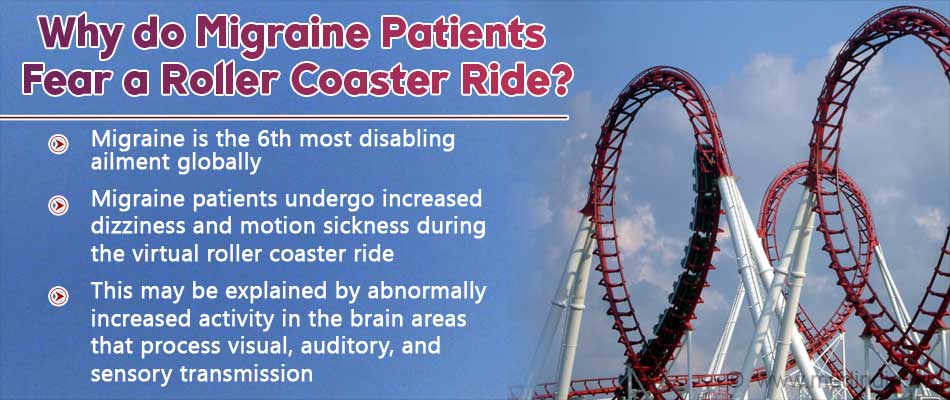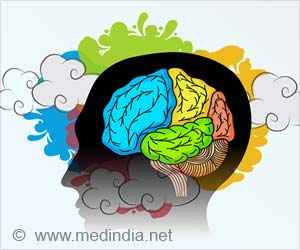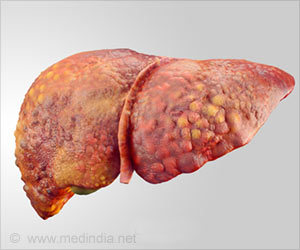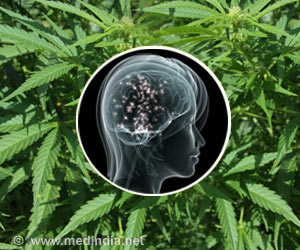Besides, certain areas of the brain had higher nerve cell activity during the roller coaster ride while other areas persisted with lesser activity among these migraine patients. This may be due to
(generally on one side), that can last for hours to days along with other symptoms like
, vomiting, and increased sensitivity to light and sound.
The migraine pain often worsens with movement or activity and it affects more than one in ten people. Women are three times more likely to suffer from migraines when compared to men.
“Millions of people regularly experience painful and debilitating migraine headaches that can reduce their quality of life. People with migraine often complain of dizziness, balance problems and misperception of their body’s place in space during migraine. By simulating a virtual roller coaster ride, our study found that some of these problems are not only magnified in people who experience migraine, but they are also associated with changes in various areas of the brain. By identifying and pinpointing these changes, our research could lead to a better understanding of migraine which could in turn lead to the development of better treatments,” says study author Arne May, MD, Ph.D., of the University of Hamburg in Germany.
The Migraine Study
The study equaled 20 people with migraines (four episodes per month) to 20 people without migraines with an average age of 30 years. More than 80% of the population were women.
The brain imaging was done simultaneously using functional magnetic resonance imaging (fMRI) among the participants as they experienced the virtual roller coaster ride videos. Migraine episode was not reported in any participants during the videos.
The participants were then surveyed regarding their symptoms of dizziness, motion sickness (score symptom intensity on a scale of 1-180), and others after the virtual rides.
Disabling Nature of Migraine
It was found that 65% of people with migraines reported dizziness with an average motion sickness score of 47 when compared to 30% of people without migraines having an average motion sickness score of 24.
These symptoms were even longer (average of 1 minute and 19 seconds) and more intense in migraine patients when compared to an average of 27 seconds among people without migraines.
Brain Activity and Migraine
The blood flow to the brain areas is associated with changes in nerve cell activity. Five areas of the brain including two areas in the occipital gyrus (the visual processing area of the brain) and the pontine nuclei (regulates movement) showed increased activity in people with migraines.
Reduced activity was observed in two other areas including the middle frontal gyrus. The imaging changes in the brain were found to be directly associated with disabling symptoms of migraine.
“This increased activity could relate to abnormal transmission of visual, auditory and sensory information within the brain. Future research should now look at larger groups of people with migraine to see if our findings can be confirmed,” says May.
Facts and Figures on Migraine
-
Migraine is the 3rd most prevalent and 6th most disabling ailment globally that attacks 12% of the population including children. - In America, migraine affects 10% of children, 18% of women, and 6% of men.
-
Almost 1.2 million emergency visits in the U.S. are for acute migraine bouts and it affects someone every 10 seconds. -
Migraine ensues most commonly among the age group of 18 to 44 years with 90% of patients having a family history of migraine. -
Although average migraine attacks occur once or twice per month, more than 4 million people experience chronic daily migraines (at least 15 migraine days per month). -
One in every 4 women suffers from migraines in their lives with 85% of chronic migraine patients being women.Migraine harms the mental health of 71% of sufferers. - Despite existing disabilities, headache is underestimated, under-recognized and under-treated throughout the world.
Managing Migraine
Despite its debilitating nature, migraine attacks can be prevented by managing the symptoms:
- Record your symptoms and numbers of debilitating attacks.
- Avoid or change the common triggers that induce a migraine.
- These triggers may include food choices, lifestyle habits, hormonal therapies, and climatic changes.
- Stay away from noisy areas and strong smells/odors.
- Protect yourself from aversive climatic changes (e.g., peak summer).
-
Mild headaches can be eased using over-the-counter pain killers like acetaminophen, or ibuprofen, upon consulting with your doctor. Do not treat yourself. -
Drugs prescribed by the specialists must be taken throughout their complete course for effective results. - Limit stress and do not overstrain yourself.
- Schedule a regular sleep cycle. Avoid light triggers from technical gadgets (mobile phones) at night.
-
Practice relaxation techniques like yoga and exercises. -
Ensure proper nourishment through a healthy diet and plenty of water intake. -
Consult your specialist in case of any worseness in headache.
References:
- What Does A Virtual Roller Coaster Ride Tell Us About Migrain?
– (https://www.aan.com/PressRoom/Home/PressRelease/4910) - Headache disorders
– (https://www.who.int/news-room/fact-sheets/detail/headache-disorders) - Raising Money for
Migrain Research – (https://migraineresearchfoundation.org/about-migraine/migraine-facts/) - Impact of migraine
– (https://migrainetrust.org/understand-migraine/impact-of-migraine/) - 5 Surprising Facts About Migraine Headache
– (https://www.scripps.org/news_items/6103-surprising-facts-about-migraine)
Source: Medindia



